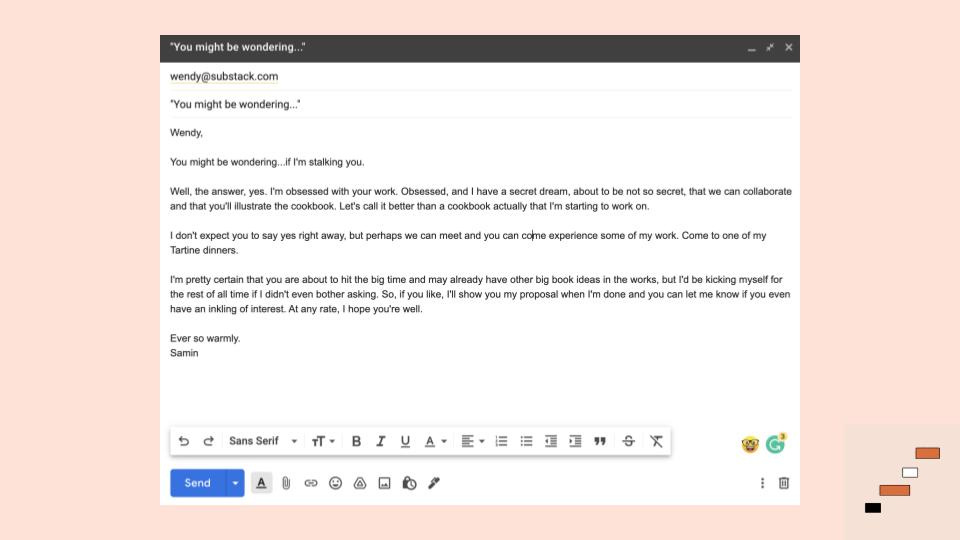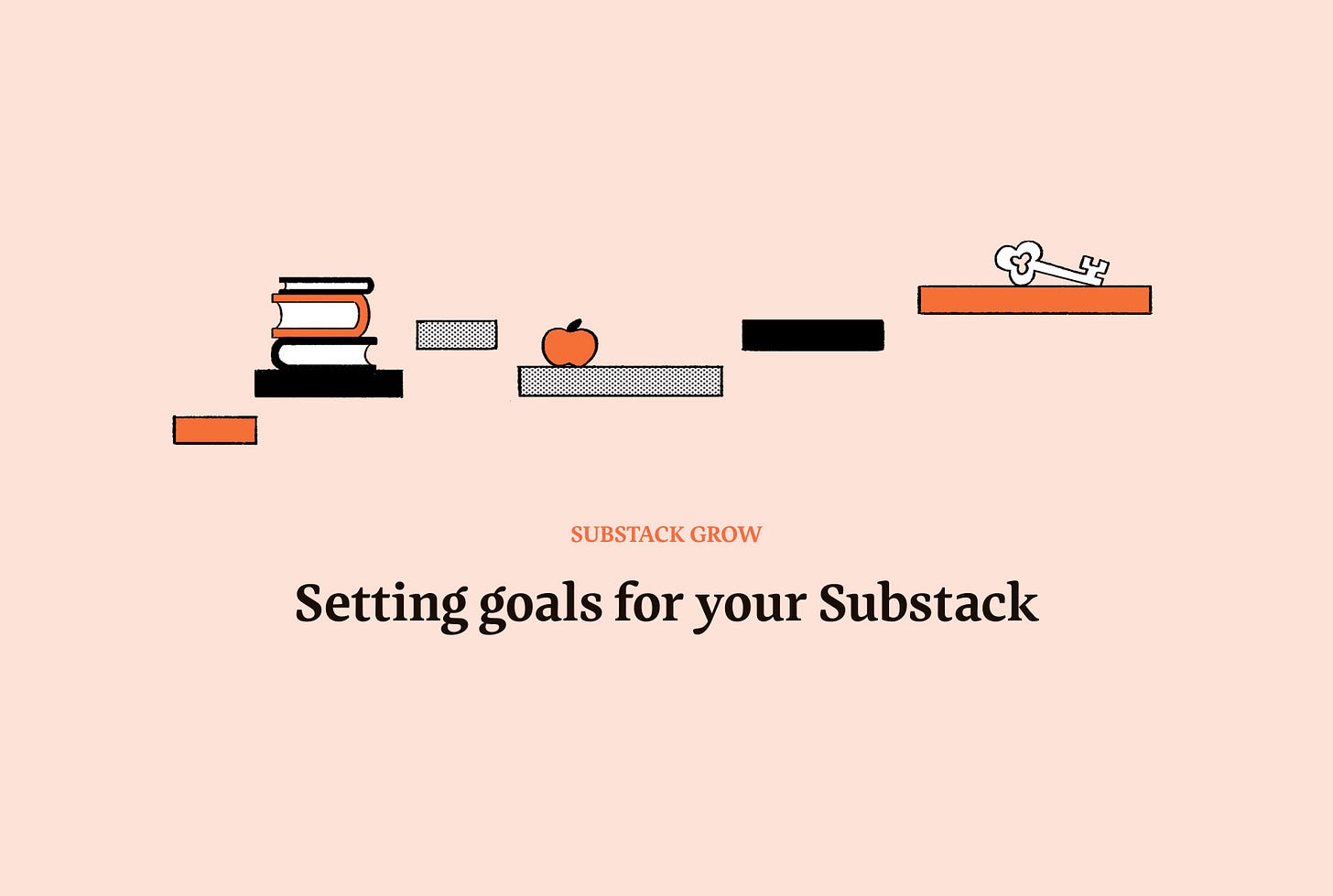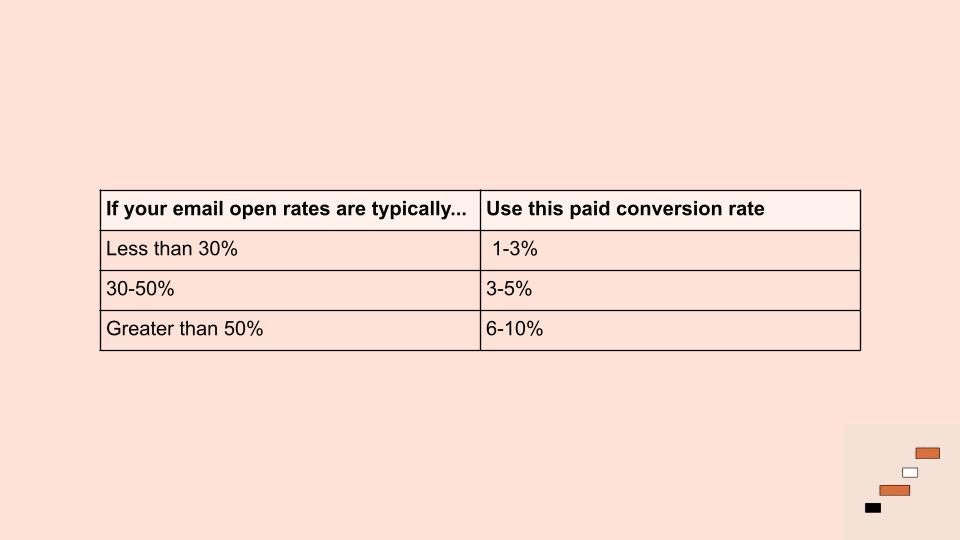This is the first in a series of six posts designed to share the essential knowledge writers need to go independent on Substack.
Growing your publication begins with planting the right seeds. If you’re ready to commit to building a publication on Substack, it’s important to take the time to get clear on why you’re writing and what you hope to accomplish. Writers can’t achieve goals if they don’t take the time to set them.
This post will guide you through the process of setting personal goals, rooting yourself in a confident mindset, and developing financial expectations for a publication on Substack.
Setting your personal goals
First, ask yourself: Why do you want to write on Substack?
There are a wide range of legitimate reasons to start a newsletter. Here are a few ideas to get you started – reflect on what best matches your current goals, and get more specific if you can.
I want to write on Substack in order to…
Support myself with extra income
Write about something I can’t elsewhere
Meet people in my field
Learn something new about a subject
Flesh out my writing portfolio
Build an audience or community of readers
Write down your initial goals, but keep yourself open to letting them change over time.
“I've always been a freelancer, and I've spent probably years of my life pitching into email black holes where no one gets back to me and I think I have this great idea. And so taking the pitching out of writing for me is just such a gift.”
If you feel goal fatigue, keep this in mind:
If thinking about goals is what’s stressing me out, the solution is not to abandon them outright, but to shift my mindset. I’ve been so focused on forcing myself to focus, I’ve neglected to address some basic wellbeing practices. As Chaturvedi put it, “If you try to move the goalposts multiple times, you'll only end up feeling tired of running.”
Anna’s insight is a reminder to make goals work for you. Root them in your deepest motivations, such as developing as a writer, not a carrot to endlessly chase.
Establishing your mindset
Let’s be honest: going independent is a scary prospect! It’s totally normal to be nervous or uncertain about whether anyone will read or pay for your work. As writers, we don’t always know what we’re worth, or we’ve been paid in ways that don’t adequately capture what we’re worth.
One fear we hear from writers is that they don’t have anything special to offer readers. But you’re not selling lemonade, or any other sort of transactional product that you have no personal relationship to. You’re selling your perspective on the world, which is reflected in the writing you publish.
Asking for money reminds readers about the creativity, labor, and expertise that goes into your writing – something that can be easy to forget in the age of free, ad-based content on social media. At the same time, paid subscriptions help you as a writer think more seriously about your publication, creating a virtuous cycle.
I believe in people getting paid for their labor, and as joyful as the labor is for me, it is labor. It actually grew my audience to ask for money, because it made people realize, "Oh yeah, this is labor that she puts into this.”
- Courtney Martin, The Examined Family
Here are a few simple exercises you can do to build confidence in yourself and your voice as a writer:
Write down what’s holding you back. Write a short (<1 page) reflection on what you’re nervous about. Then identify one thing you can do to counteract those fears, or ask a fellow writer how they approach similar anxieties.
Hype yourself up. Write a short (2-3 paragraph) review of your own work, as if you were your own biggest fan. Read previous compliments from readers and editors for inspiration. What makes your writing great? Why should someone read it?
Finally, launching a Substack publication isn’t a one-and-done moment. Even if your launch doesn’t go the way you hope, a newsletter is a great testing ground to experiment with different kinds of writing, hear from readers about what resonates, and build an audience continuously over time.
When to consider going paid
One of the most common questions we get from writers is whether they’re ready to go paid. There’s no foolproof formula for when to go paid, although we’ll share some benchmarks to help you get oriented.
First, understand that going paid is a commitment to yourself and your readers.
We’ve found that writing regularly and consistently is the biggest predictor of success for new Substack writers. Before going paid, take an honest look at your capacity to make sure that you have the time, interest, and commitment to do so. We usually recommend writing at least once a week for both your free and paid subscribers, and you’ll also want to invest time into promotion, brand, and other aspects of running an independent writing business.
Going paid also requires understanding your relationship to your readers.
The value of your writer-reader relationship can be measured along two major axes:
Your reach: the size of your readership
Your engagement: how much your readers pay attention
In order to benchmark those, however, you’ll first need to identify your financial goals for going paid. If you’re going full-time, your financial needs might be different from a writer who wants a part-time side project.
In the best of circumstances, writers typically see conversion rates of 5-10% from free to paid readers, although it can be much higher. You can use your email open rates as a rough proxy for your publication’s conversion rate.
Next, you’ll want to identify a price. At this early stage, we recommend just doing napkin math. Most newsletters charge $5-10/month or $50-100/year, while business newsletters that readers expense to their employers might charge closer to $10-50/month or $100-500/year.
Multiply your free email list size by your approximate conversion rate, then multiply that by your price. Compare the number you get with your initial financial goals.
If your estimated earning potential is below your goals, don’t worry. You have levers to improve your reach and engagement. And, you can always change your price.
To increase your reach, invest in promotion and building a support network. (See below!)
To increase your engagement, double down on high quality, consistent writing.
To increase your price, explore different pricing tier options.
The rest of the posts in this series, which will come to your inbox weekly for the next month and a half, will be all about how you can best use these levers.
Build your support network
Starting a publication is a big lift, and you don’t have to do it alone. From the beginning, we recommend developing a support network of readers, writers, and friends.
Think of three friends, peers, supporters, or mentors who have encouraged your writing in the past. Reach out to them today, and tell them that you’re launching a Substack publication. Share your hopes and fears, ask for advice, or simply talk through the questions you’ve begun thinking through.
Next, practice asking for things by reaching out to someone new. Find someone whose work you admire. Write a short – no more than 3-5 sentences – cold email asking them one thoughtful question. Check out these tips for writing a cold email.
What makes a good cold email:
Do research on the person you’re reaching out to
Introduce yourself, including any shared interests or relevant background
Make a specific ask by including a question in the email itself
Keep it brief: a few short paragraphs is good enough
Be gracious: acknowledge that they may not have time to respond

Finally, we hope that the Substack writer community is another resource you can lean on for learning and support. Join us on Thursdays for our Office Hours, where the Substack team, and your fellow writers, gather to answer questions live about publishing, growing, or going paid on Substack.
This post is the first in a series of six posts that will share the essential knowledge writers need to go independent on Substack.
The material is based off the curriculum for Substack Grow, a six-session crash course for writers ready to pursue independence by building a loyal readership and kickstarting paid subscriptions. Setting goals for your Substack was session one. Learn more here.




